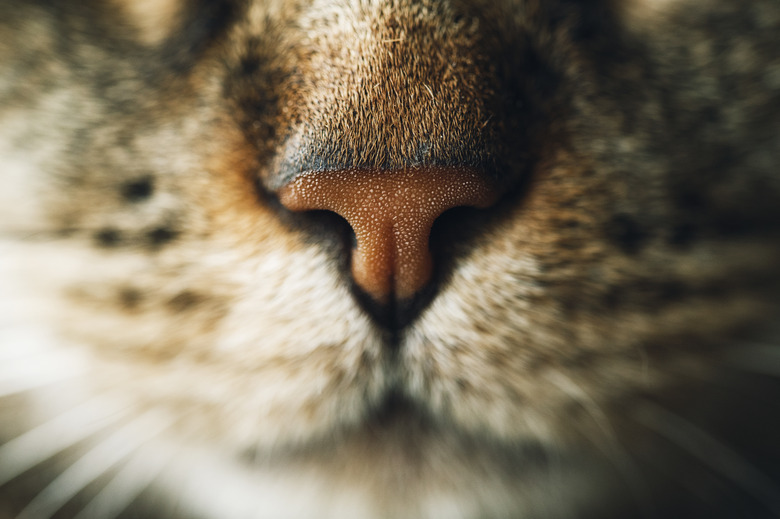Why Is My Cat Sniffing The Air?
There's no question that cats exhibit a range of weird behaviors that don't seem to make sense to humans. Whether it's bringing you dead animals, squeezing themselves into tight spaces, or running around the living room like they are being chased at 2 a.m., cats are unique animals. Sometimes, their weird behavior has to do with the fact that they have senses that are more sensitive to certain things than humans are.
Cat's sense of smell
Cat's sense of smell
Cat senses are different than that of humans. As a human, you might use your sense of smell to tell when someone is baking cinnamon rolls in the kitchen downstairs. If you smell smoke, you might begin to wonder if there's a fire nearby. But in general, your sense of smell is not the primary way that you navigate your environment.
For cats, though, their sense of smell is their strongest sense. According to Cats International, cat's eyesight prowess is 10 times less than that of humans. However, humans have 5 million odor-receptive cells in their noses whereas cats have 200 million. That means a cat can smell a whole "world" of sensory information from their noses that humans have no awareness of.
The Flehmen response and Jacobson's organ
The Flehmen response and Jacobson's organ
A cat's sense of smell is so important that they have a whole secondary organ for it. The Jacobson's organ, which picks up general scents from the air and hormonal information, such as other cats that are nearby. It's located on the roof of their mouth behind their front teeth and is connected to the nasal cavity. The Jacobson's organ, also known as the vomeronasal organ, is found in amphibians, reptiles, and mammals, although in humans the size and shape of the organ varies widely and in fact research shows that in humans the organ is non-functional.
In cats, the Jacobson's organ detects odor particles that are carried on moisture in the air. Some mammals that have a Jacobson's organ, like cats, exhibit a behavior known as the Flehmen response. This is a behavior in which the cat tries to expose as much of the odor-bearing air to the Jacobson's organ as possible by opening their mouth and curling their upper lip as they breathe.
If you see your cat sniffing something with their eyes squinty, their mouth open, and their head tilted back, it probably doesn't mean they don't like the smell of whatever you're cooking for dinner. It simply means they are "tasting the air," or trying to get as much information as possible about the smell. Passing the air over the organ intensifies the odor and provides more information about what they're sniffing. Whether the cat sense of smell is so sophisticated that they can figure out if you're making pepperoni pizza or baking a cake, we'll never know.
Sniffing the air
Sniffing the air
Since cats can't see as well as we can, sniffing the air using their Jacobson's organ is a way for them to get a "scent picture" of what is going on in their environment. A cat can smell a mouse, for instance, which might be in the walls which you can't even hear or see. If you think about it, it makes sense that cats can smell so much better than we can, because kittens are born with their eyes closed and they can only identify their mother and find her nipples by smell.
If you see your cat sniffing the air, particularly if he's an unfixed male, he could be looking for love. Hormonal cues are a huge part of cat mating, and male cats can smell a female cat in heat from up to a mile away. If there are other cats in the neighborhood, your cat may be sniffing for their scent markings. It's a way of cats letting other cats know, "I'm here."
Other species have scent organs that allow them to "taste the air," including snakes, which stick their tongues out, and elephants, who stretch out their trunks. Male cats are thought to be more likely to display a Flehmen response because he is looking for a female cat. But a female cat who is a mother will use the response to look for her kittens.
Both male and female cats may use the response to look for potential food sources. Some evidence seems to suggest that animals may go into a trance-like state during the process because they enjoy it so much.
Sniffing
Sniffing
Sniffing is a similar behavior to sniffing the air with their mouth open using the Jacobson's organ. A cat can smell scents from both near and far, and sniffing is a way of bringing more air into the nasal cavity, where the olfactory smell receptors are located.
Cats communicate with scent
Cats communicate with scent
Cats detect scent that can tell them a lot of things. They may smell when other cats mark or spray with urine. They can learn information about the cat that left the mark by sniffing it. A cat leaves hormones when it rubs or scratches on something. So your cat may sniff a bush or the arm of the couch if it senses that another cat, or another animal of some kind, has been there.
Cats use scent to communicate territorial areas, identify other cats they know, identify other friendly or unfriendly animals like the dog that lives next door, or they may be seeking a mate if they are not fixed.
Cats have two noses
Cats have two noses
No, they don't really have two noses, but the presence of their actual nose along with the Jacobson's organ is like they have two noses. According to Your Cat, a cat has 20-square centimeters of surfaces that receive scent compared to the two- to four-square centimeters that humans have. While their actual "nose" is anatomically similar to ours, they can get a lot more information from scent than we can.
So while your cat may seem like she is jut acting weird by sniffing the air, she's likely studying what she's smelling and remembering it in case she smells it again.
References
- Cats International: The Amazing Sense of Smell
- Frontiers in Neuroanatomy: The Vomeronasal Organ: A Neglected Organ
- Brittanica: Jacobson's Organ
- Mother Nature Network: A Cat's Nose Knows More Than You Think
- Vets Help Direct: Why is My Cat Tasting the Air?
- Canidae: Why Do Cats Leave Their Mouths Open?

